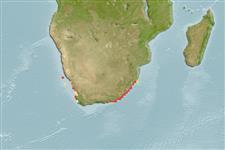Common names from other countries
Environment: milieu / climate zone / depth range / distribution range
Ecología
marino; salobre demersal; rango de profundidad 10 - ? m. Subtropical; 28°S - 34°S
Southeast Atlantic: Mossel Bay to Natal in South Africa.
Length at first maturity / Tamaño / Peso / Age
Maturity: Lm 57.5 range ? - 70 cm
Max length : 200 cm TL macho / no sexado; (Ref. 3198); common length : 100.0 cm TL macho / no sexado; (Ref. 3507); peso máximo publicado: 80.0 kg (Ref. 4537)
Short description
Claves de identificación | Morfología | Morfometría
Espinas dorsales (total) : 11; Radios blandos dorsales (total) : 10 - 11; Espinas anales: 3; Radios blandos anales: 8. Reddish, bronzy or golden-yellow in color; young with a blotch behind dorsal fin.
Found near rocky banks in coastal waters including estuaries. Adults solitary and territorial. Feeds on octopus, crabs and fish, especially Spondyliosoma. The flesh is highly esteemed, but the liver is poisonous due to high vitamin A content which causes hypervitaminosis. Popular angling fish. Largest of the porgies.
Life cycle and mating behavior
Maturities | Reproducción | Spawnings | Egg(s) | Fecundities | Larva
Smith, J.L.B. and M.M. Smith, 1986. Sparidae. p. 580-594. In M.M. Smith and P.C. Heemstra (eds.) Smiths' sea fishes. Springer-Verlag, Berlin. (Ref. 3198)
IUCN Red List Status (Ref. 130435)
CITES (Ref. 128078)
Not Evaluated
Threat to humans
Poisonous to eat (Ref. 3507)
Human uses
Pesquerías: escaso valor comercial; pesca deportiva: si
Herramientas
Special reports
Download XML
Fuentes de Internet
Estimates based on models
Preferred temperature (Ref.
115969): 15 - 24, mean 22.2 (based on 10 cells).
Phylogenetic diversity index (Ref.
82804): PD
50 = 1.0000 [Uniqueness, from 0.5 = low to 2.0 = high].
Bayesian length-weight: a=0.01549 (0.00889 - 0.02698), b=3.04 (2.89 - 3.19), in cm Total Length, based on LWR estimates for this species & (Sub)family-body (Ref.
93245).
Nivel trófico (Ref.
69278): 4.5 ±0.61 se; based on food items.
Resiliencia (Ref.
120179): Bajo, población duplicada en un tiempo mínimo de 4.5-14 años (K=0.08; tm=5-7; tmax=30;).
Fishing Vulnerability (Ref.
59153): Very high vulnerability (80 of 100).
Climate Vulnerability (Ref.
125649): Very high vulnerability (92 of 100).
